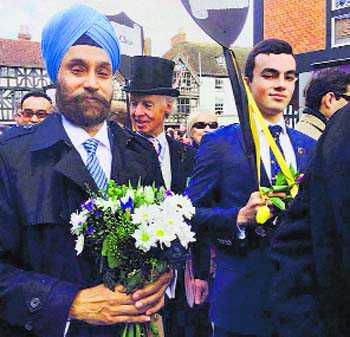London, April 24
Speaking on behalf of the diplomatic corps at the 452nd birthday celebrations of the Bard at Stratford-upon-Avon, his birthplace, yesterday, Sarna said: “Shakespeare lived for the most part of his life at the time when India was ruled by Akbar, the great Moghul.
“Yet India was not unknown to Shakespeare... he picked up information and stories from sailors in London and his imagination did the rest. His India is exceptionally rich, famous for its precious pearls and stones, its people are deeply religious and its veiled women famed for their dark beauty.”
He noted there were various references to India in Shakespearean plays, with four references in “A Midsummer Night’s Dream”.
Sarna said the earliest reference to India was in “King Henry VI” (Act III, Scene I): “My crown is on my heart, not on my head; not decked with diamonds and Indian stones, nor to be seen: my crown is called content, a crown it is that seldom kings enjoy.”
There were other references too in “Troilus and Cressida”, “The Merchant of Venice” and “All’s Well that Ends Well”.
Sarna said by the mid-1700s, less than 150 years after the world’s pre-eminent dramatist’s death, his plays had begun to be staged in Calcutta and Bombay for the entertainment of Europeans.
“The earliest dramatisations of Shakespeare by Indians were of scenes in schools and colleges,1822 is the first such known performance at Hindu College, Calcutta. It initiated a tradition which it has continued to this day. In the next 100 years, the first translations of Shakespeare in an Indian language were ready,” he said.
The High Commissioner said it was only a matter of time before filmmakers in India began to mine Shakespeare for material. “In one of the earliest talking movies, or talkies as they were known, filmmaker and actor Sohrab Modi played Hamlet in his movie called ‘Khoon’ (1935). This was followed in 1941 by JJ Madan’s take on ‘The Merchant of Venice’ (Zalim Saudagar)”.
“These earlier formalistic and more faithful representations of Shakespeare have given way in independent, post-colonial India to freer transplanting of Shakespeare to fit into local modern Indian settings, be these in glamour-laden Bollywood adaptations of ‘Comedy of Errors’ or of ‘Romeo and Juliet’ or in tense angst-ridden films like ‘Maqbool’ (Macbeth), ‘Omkara’ (Othello) and ‘Haider’ (Hamlet). He referred to a recently conducted YouGov poll for the British Council that covered 18,000 people across 15 countries to mark the 400th death anniversary of the Bard this month.
According to the report titled ‘All the World’s’, as many as 83 per cent of Indians said they understood Shakespeare compared to just 58 per cent of Britons. — PTI
Unlock Exclusive Insights with The Tribune Premium
Take your experience further with Premium access.
Thought-provoking Opinions, Expert Analysis, In-depth Insights and other Member Only Benefits
Already a Member? Sign In Now










